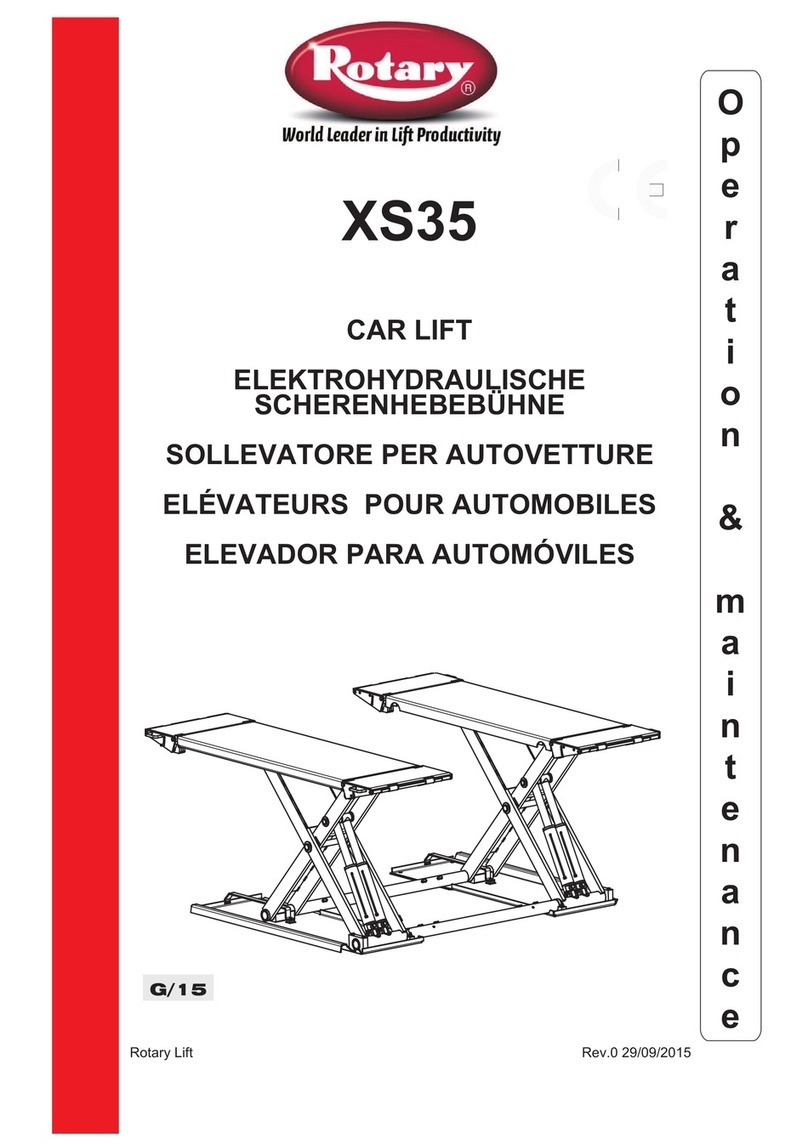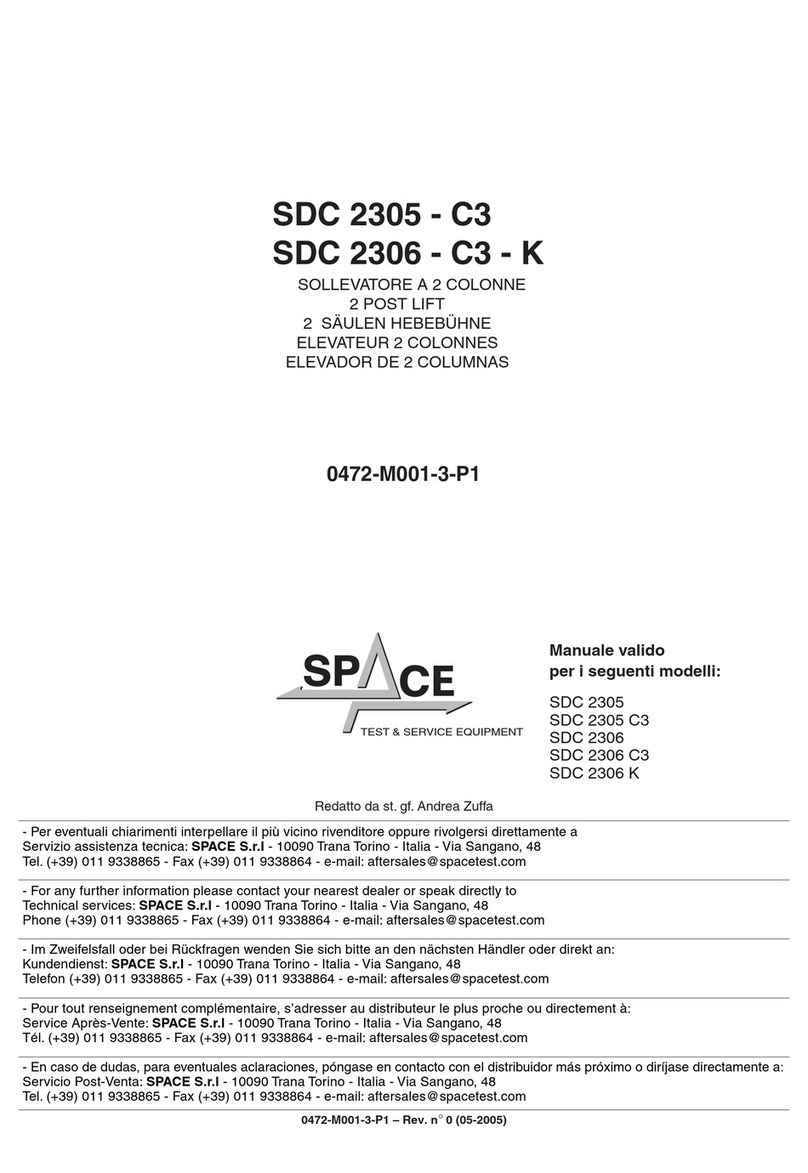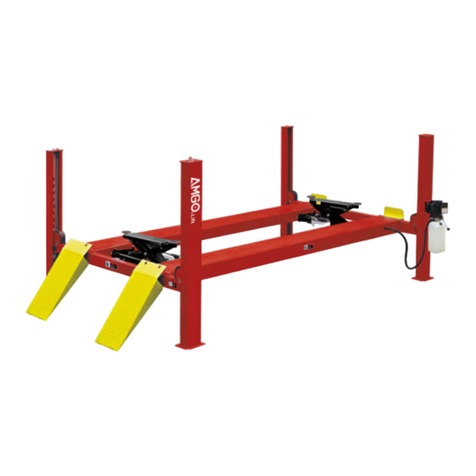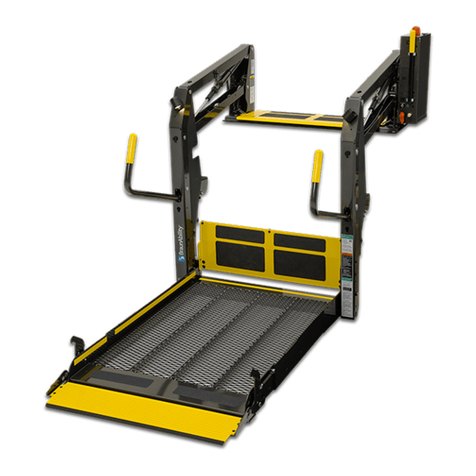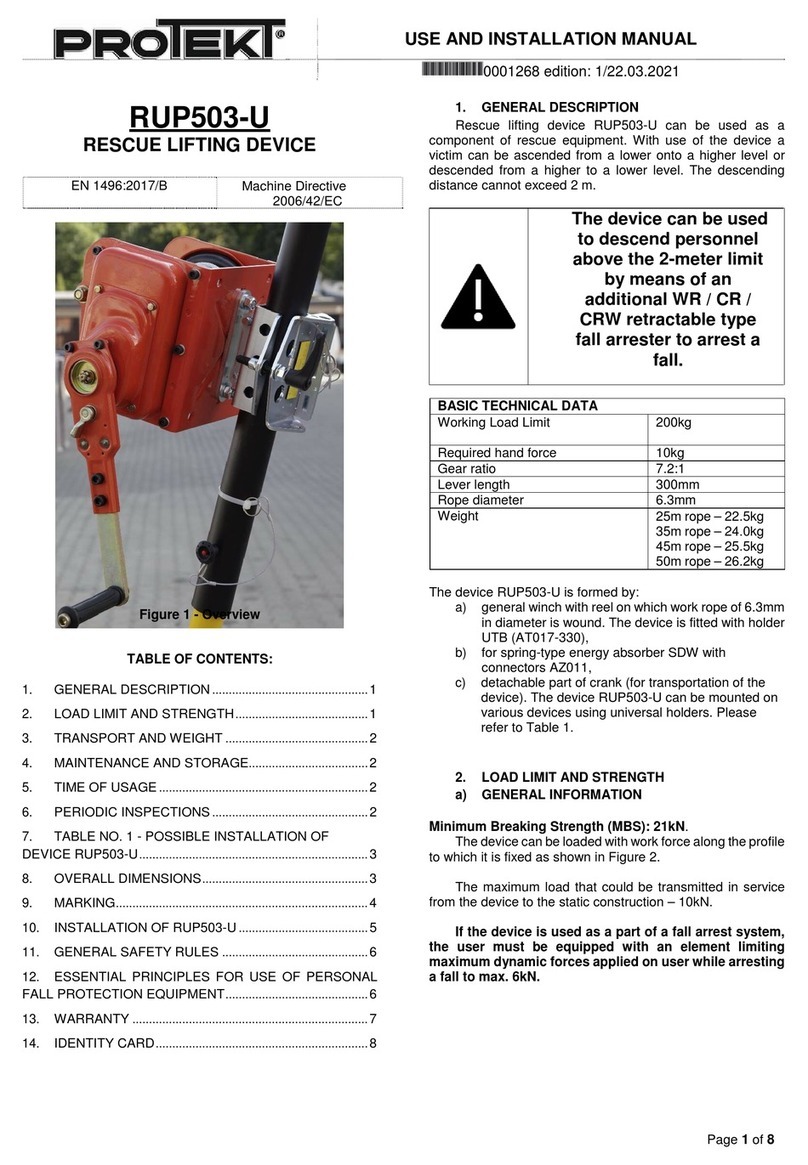Flexco Flex-Lifter User manual

www.flexco.com
Flex-Lifter
Belt Lifters
Installation, Operation
and Maintenance Manual
Flex-Lifter with lifting rods, examples
Please read before use.
Retain for further use.
Flexco Europe GmbH

Point of contact
Postal Address Flexco Europe GmbH
Leidringer Straße 40 – 42
D – 72348 Rosenfeld
Phone +49 (0)7428 – 9406 - 0
Fax +49 (0)7428 – 9406 - 260
E-mail europe@flexco.com
Internet www.flexco.com
Customer service information
See above for address.
Storage
The operating instructions must always be kept near to the machine.
It must always be accessible
Copyright Protection
©2016 Flexco Europe GmbH
Leidringer Straße 40 - 42
D – 72348 Rosenfeld/Germany.
All rights reserved.
Reproduction, in whole or in part, permitted only
with the consent of Flexco Europe GmbH

3
Table of Contents
Section 1 - Basic specications................................................................................................................................ 5
1.1 Warranty, Limitation of Liability......................................................................................................................5
1.2 Intended Use .......................................................................................................................................................5
1.2.1 Reasonably Foreseeable Misuse........................................................................................................................6
1.3 Supplied Documents..........................................................................................................................................6
1.4 User Evaluation/Product Monitoring..............................................................................................................6
1.5 Labels on the Device ..........................................................................................................................................7
1.6 Operator’s Work Station ....................................................................................................................................7
Section 2 - Safety Information ................................................................................................................................ 8
2.1 General.................................................................................................................................................................8
2.1.1 Comply with the Instructions in the Operating Manual ..............................................................................8
2.1.2 Obligation of the Operator................................................................................................................................8
2.1.3 Obligation of the Personnel ..............................................................................................................................8
2.2 Explanations of Symbols and Signs..................................................................................................................8
2.2.1 Warning Signs and Information.......................................................................................................................8
2.2.2 Symbols................................................................................................................................................................9
2.3 Organizational Measures.................................................................................................................................10
2.4 Selection and Qualications of Personnel.....................................................................................................10
2.5 Dangers when Handling the Device ..............................................................................................................10
2.5.1 Hazardous Areas and Potential Hazards .......................................................................................................11
2.5.2 Residual Hazards ..............................................................................................................................................11
Section 3 - Product Description............................................................................................................................ 16
3.1 Ordering Numbers, Part Numbers ................................................................................................................16
3.1.1 Flex-Lier ..........................................................................................................................................................16
3.1.2 Liing Rods for Return Belts ..........................................................................................................................16
3.1.3 Transport Carriage ...........................................................................................................................................16
3.2 Technical Specications...................................................................................................................................17
3.2.1 General Information on Flex-Lier ...............................................................................................................17
3.2.2 Permissible Safe Liing Capacity, Depending on the Liing Height ........................................................17
3.2.3 Checking the Liing Capacity at the Manufacturer ....................................................................................17
3.2.4 Reaction of the Flex-Lier in the Event of Overloading.............................................................................18
3.2.5 Permissible Towable Load of the Liing Rod ...............................................................................................18
3.2.6 Liing Rods for Return Belts ..........................................................................................................................19
3.2.7 Transport Carriage ...........................................................................................................................................19
3.2.8 Necessary Accessories......................................................................................................................................20
3.2.9 Power Wrench...................................................................................................................................................20
3.2.10 Environmental Conditions..............................................................................................................................20
3.2.11 Information on Noise.......................................................................................................................................20
3.3 Delivery State ....................................................................................................................................................21
3.4 Construction of the Flex-Lier.......................................................................................................................22
3.4.1 Flex-Lier Sizes M and L.................................................................................................................................23
3.4.2 Flex-Lier Size XL............................................................................................................................................25
3.4.3 Chains on the Liing Rods for Return Belts.................................................................................................28
3.4.4 Blade Pins on the Extendable Foot Sections.................................................................................................29
3.4.5 Blade Pins on the Troughing Belts .................................................................................................................29
3.4.6 Nut Driver for Adjusting the Height of the Flex-Lier ...............................................................................30

4Flex-Lifter Belt Lifters
3.4.7 Safety Bolts on the Liing Rod .......................................................................................................................31
3.4.8 Transport Carriage ...........................................................................................................................................31
3.5 Typical Application Examples.........................................................................................................................32
Section 4 - Transport............................................................................................................................................. 33
4.1 Safety Regulations.............................................................................................................................................33
4.2 Requirements of the Operating Personnel....................................................................................................33
4.3 Scope of Delivery, Transportation Damage ..................................................................................................33
4.4 Internal Transport ............................................................................................................................................34
4.5 Use of the Transport Carriage (Optional).....................................................................................................35
Section 5 - Operation and Handling..................................................................................................................... 38
5.1 Safety Regulations.............................................................................................................................................38
5.2 Requirements of the Operating Personnel....................................................................................................39
5.3 Cleanliness.........................................................................................................................................................39
5.4 Flex-Lier Set-up..............................................................................................................................................40
5.4.1 Application on the Upper Flange ...................................................................................................................43
5.4.2 Application on the Return Belt.......................................................................................................................43
5.5 Decommissioning, Storage and Re-starting .................................................................................................47
5.6 Operational Maintenance by Operating Personnel .....................................................................................48
Section 6 - Malfunctions, Repairs......................................................................................................................... 49
6.1 Safety Regulations.............................................................................................................................................49
6.2 Malfunctions, Possible Causes, and Solutions..............................................................................................49
Section 7 - Disposal ............................................................................................................................................... 50
7.1.1 Safety Regulations.............................................................................................................................................50
7.1.2 Environmental and Health Risks....................................................................................................................50
Section 8 - EC Declaration of Conformity............................................................................................................ 51
Section 9 - Annex................................................................................................................................................... 52
9.1 Conrmation of Instruction ...........................................................................................................................52
Section 10 - Keywords ........................................................................................................................................... 53
Table of Contents continued

5
1.1 Warranty, Limitation of Liability
Section 1 – Basic Specifications
Information!
Please note that the contents of this manual are not to be used or amended as part of any previous
or existing agreement, commitment, or legal relationship. All obligations of Flexco Europe GmbH/
the supplier arise from the respective purchase agreement, which also contains the complete and
solely applicable warranty regulation. ese contractual warranty provisions are neither extended nor
restricted by the instructions in this operating manual.
e information in this operating manual has been carefully checked. Nevertheless, we can accept no
liability for any errors. To the best of our knowledge, all information and instructions for operation and
maintenance result from consideration of our previous experience and ndings. With the exclusion of
further claims, we are liable for any errors or omissions as part of the warranty obligations within the
purchase contract. Claims for compensation, regardless of the legal reason for such claims, are excluded.
Flexco Europe GmbH assumes no liability and warranty for damage and malfunctions resulting from
non-compliance with this operating manual, improper installation or improper repairs by the personnel
of the operator.
Contact Flexco Europe GmbH if complications and uncertainties arise. In this way, major damage can
be avoided. Repairs may only be made by Flexco Europe GmbH. Only genuine replacement parts may
be used for repairs.
1.2 Intended Use
e Flex-Lier belt lier is intended solely for the raising and lowering of belts on conveyor belts.
e drive is carried out manually with an appropriate ratchet or by using a suitable power wrench (not
included as part of Flex-Lier). Any other or additional use is considered to be improper, and is a misuse
of the device.
• e Flex-Lier must be positioned securely in the frame of the conveyor belt, so that it can neither fall
nor tilt.
• e substrate must be suciently loadbearing.
• e drive of the conveyor belt must be stopped safely prior to raising. e belt must not move laterally
during the liing process. If necessary, it must be eectively blocked before liing.
• e safety distance from the top roller or the end roller must always be at least6m.
• e maximum permissible working widths, heights and liing capacities must not be exceeded, see
Section 3.2.
• e liing rods of the return belt are intended exclusively to be attached to the ends of the troughing
belts. Please note the maximum permissible towing capacity.
• Please note the maximum permissible load of the liing rods for the return belt. Only use the liing
rods for the return belt with the original chains and accessories.
• e permissible environmental conditions must be complied with, see Section3.2.

6Flex-Lifter Belt Lifters
Section 1 – Basic Specifications
1.2 Intended Use continued
e intended use also includes:
• complying with the operating instructions,
• complying with the inspection and maintenance work.
1.2.1 Reasonably Foreseeable Misuse
• e liing of belts with larger dimensions or a heavier weight.
• e liing of other products (e.g. motor vehicles) or living things (e.g. people).
• Unauthorized modications to the device.
• Welding work on the device.
• Operating the device in an explosive atmosphere.
1.3 Supplied Documents
• Operating manual
1.4 User Evaluation/Product Monitoring
We update this operating manual on a regular basis.
Your suggestions for improvement help to make it more user-friendly.
As we also want to oer you safe, state-of-the-art technology in the future, please inform us immediately
of any
• malfunctions during operation,
• issues when handling the device,
• accidents or near-misses.
We will then get in touch with you, to discuss the safety and operation of the device.
Information!
Notifying us of accidents or near-misses is an essential contribution to the improvement of the device.

7
1.6 Operator’s Work Station
e operator’s work station is marked with an “X” in Figure 2.
e work station for raising and
lowering is on the adjusting nut of
the narrow side of the Flex-Lier
frame.
ere are other work stations
around the device for adjusting the
foot sections and the troughing
belts, for attaching and adjusting
the liing rod (optional), and for
inserting or liing the Flex-Lier.
Danger!
Set up the device so that you can
operate it safely.
• Move any obstructions out of the
way beforehand.
• Make sure that the installation site is adequately lit.
• Ensure secure positioning and safe access.
• In workstations at heights greater than 0.5 m above the ground, you must take the necessary safety
measures to prevent falls, e.g. construct scaolding with railings.
• Use the required personal protective equipment, e.g. a protective helmet, protective gloves, protective
footwear, fall protection.
Labels are used to identify the device. ey are
mounted onto the frame (approximately in
the center), and provide information about the
device type and the serial number (Figure 1).
e correct type is marked in the check box on
the le label. e serial number can be found on
the label on the right-hand side.
1.5 Labels on the Device
Section 1 – Basic Specifications
Labels and their positions on the device
Fig. 1
Operator’s work station
Fig. 2 X

8Flex-Lifter Belt Lifters
Section 2 – Safety Information
2.1 General
2.1.1 Comply with the Instructions in the Operating Manual
• is operating manual contains the most important instructions for the safe operation of the device.
• is operating manual, especially the safety information, must be complied with by all persons who
work on the device.
• In addition, the rules and regulations applicable for accident prevention in the place of operation must
be observed.
2.1.2 Obligation of the Operator
e operator is obligated to only permit the following people to work on the device:
• those who are familiar with the basic regulations on workplace safety and accident prevention, and
who have been trained in the handling of the device; and
• those who have read the section on safety and warning signs in this manual, or have been informed of
its content, and have conrmed their understanding of the content with their signature.
2.1.3 Obligation of the Personnel
Before starting work, all persons who are authorized to work on the device undertake to
• comply with the basic regulations on workplace safety and accident prevention, and
• read the section on safety and warning signs in this manual, or to receive training about its content,
and to conrm with their signature that they have understood the section on safety and warning signs.
2.2 Explanations of Symbols and Signs
• Please note these signs.
• Avoid these dangerous situations.
2.2.1 Warning Signs and Information
Symbol Signal Word Meaning
Danger! Ignoring this warning sign may result in serious injury
or death.
Warning! Ignoring this warning sign may result in serious injury
or considerable damage to property.
Caution! Ignoring this warning sign may result in minor injury or
minor damage to property.
Information
This information facilitates the handling of the device,
and will help you to avoid causing damage to the
device during operation, maintenance, and cleaning.

9
2.2.2 Symbols
Section 2 – Safety Information
Symbol Explanation Symbol Explanation
Warning of suspended load Warning of hazardous area
Warning of hand injuries, e.g. by crushing Warning of a slip hazard
Warning of hand injuries, e.g. by shears
Note all safety instructions and symbols attached to the equipment. Keep them in a fully legible
condition.
Warnings:
Prohibitions:
Symbol Explanation Symbol Explanation
Do not stand beneath a suspended load Do not use as a lifting jack
Commands:
Symbol Explanation Symbol Explanation
Wear eye protection Wear protective gloves
Wear foot protection

10 Flex-Lifter Belt Lifters
Section 2 – Safety Information
2.3 Organizational Measures
• Observe the accepted rules for occupational safety.
• Check the device for externally visible damage and operability before use.
• Regularly check that your employees work in a safety-conscious and hazard aware manner, in
compliance with the operating manual.
• Use personal protective equipment, where necessary or required by regulations.
• e required personal protective equipment must be provided by the operator.
• Make sure that all safety instructions and warnings on the equipment are complete and in a fully
legible condition, and replace them if necessary.
• Do not make any changes, additions or conversions to the device which may aect your safety.
• Replacement parts must meet the technical requirements specied by the manufacturer. is is
ensured when using genuine spare parts.
• Observe the proper operational maintenance conditions, see Section 5.6.
2.4 Election and Qualications of Personnel
• Work on the device may only be carried out by reliable personnel who conform to the requirements.
Note the legally permitted minimum age.
• Only appoint trained and qualied personnel.
• Clearly determine the responsibilities of the personnel for set-up, operation, maintenance and repairs.
• Personnel who are to be trained, taught, instructed or participate in general training may only operate
the device under the constant supervision of an experienced person.
2.5 Dangers when Handling the Device
Only operate the device
• in good order and condition,
• according to the intended use, see Section 1.2.
• if the operator has the necessary safety and hazard awareness, and works in compliance with the
instruction manual.
is is for your safety!

11
2.5.1 Hazardous Areas and Potential Hazards
Section 2 – Safety Information
Hazardous Areas
• e working environment around the conveyor belt, in which the Flex-Lier isused.
• Belt bearing rail with two adjustable troughing belts.
• Scissor linkage with pivot rod.
• Frame with extendable foot sections.
• Liing rods of the return belt, if available.
Known risks or unexpected hazards exist permanently in these areas.
Potential Hazards
• Mechanical movements
• Height above the ground
• High weight forces
• Improper use of a drive tool, such as a power wrench (not part of the Flex-Lier).
• Negligent use of personal protective equipment.
is may result in a risk to the health of personnel.
Special safety regulations apply.
2.5.2 Residual Hazards
Residual hazards are hazards which
• cannot be completely eliminated constructively, or
• cannot be reduced to an acceptable level, or
• cannot be eliminated through the use of protective equipment.
ey exist permanently. Information about the residual dangers is also on the signs which are attached
to thedevice.
Danger!
Falling device or machine parts.
Never stand under a suspended or oating load.
Watch out for other people.
Warning!
e device may tilt during operation.
Ensure that the operator is qualied and authorized.
Secure the device against accidental movements, e.g. with straps.

12 Flex-Lifter Belt Lifters
Section 2 – Safety Information
2.5.2 Residual Hazards continued
Danger!
Unfavorably situated operation sites can pose risks to the operational environment.
• Set up the device so that you can operate it safely.
• Move any obstructions out of the way beforehand.
• Make sure that the installation site is adequately lit.
• Ensure secure positioning and safe access.
• In workstations at heights greater than 0.5 m above the ground, you must take the necessary safety
measures to prevent falls, e.g. construct scaolding with railings.
• Use the required personal protective equipment, e.g. a protective helmet, protective gloves, protective
footwear, fall protection.
Warning!
e device may tilt, slip or fall during operation.
e raised conveyor belt may be jerky and move downward.
During set-up, ensure that the device is on a at bearing surface, and has a secure grip on the frame
of the conveyor belt.
e width of the extendable foot sections must be properly adjusted.
e blade pins must all be reinstated and secured with split pins.
e base on which the Flex-Lier stands, must be designed for the expected maximum load.
Warning!
e device may tilt, slip or fall during operation.
With inclined conveyor belts or inclined installation areas, you are responsible for the stability of
the device, even when it is in its fully extended state.
In this case, you must also securely attach the device.
Warning!
If the conveyor belt moves laterally, the Flex-Lier may tilt and fall.
Before starting work on the unit, make sure that the conveyor belt is disconnected from the power
supply, and protected against reconnection.
Before starting work on the unit, make sure that the conveyor belt cannot move laterally. If the
bands are tilted, the belt needs to be eectively blocked by clamping.

13
2.5.2 Residual Hazards continued
Section 2 – Safety Information
Warning!
Risk of injury when searching for and rectifying faults.
Only appropriately trained and authorized persons are allowed to search for and rectify faults. See
the Section 2.4, “Selection and qualications of personnel”.
Warning!
e device has been built for “single-person operation” (raising and lowering). Risk of injury caused
by other people using the device.
Ensure that during operation, only one person is using the device.
Exception: As a general rule, two people are required to set up and dismantle the conveyor belt.
Warning!
Risk of crushing or shearing by the linkage of the Flex-Lier when raising and lowering.
Keep your hands and limbs away from the hazardous area when raising and lowering the conveyor
belt.
Caution!
Danger of electrostatic charging.
If you install the Flex-Lier on an electrically non-conductive base, possible electrostatic charges
cannot ow. In this case, earth the Flex-Lier.
Warning!
If the conveyor belt is too heavily loaded on the Flex-Lier, the Flex-Lier can buckle or break. Note
the maximum permissible liing capacity, depending on the liing height, see Section 3.2.2.
If in doubt, you must relieve the belt by removing the conveying material and, if necessary, reducing
the belt tension.
Limit the torque of the ratchet or the power wrench whilst raising the Flex-Lier.
Ensure that the safety distance from the head and end rollers of the conveyor belt is at least 6m.

14 Flex-Lifter Belt Lifters
Section 2 – Safety Information
2.5.2 Residual Hazards continued
Warning!
Do not use a bent, fractured or otherwise damaged Flex-Lier. Only operate the device if it is
functioning properly.
Stop the device immediately if you notice an error.
As the operator, you are responsible for this.
Warning!
Danger of crushing in the event of unstable liing rods of the return belt.
If you adjust the liing rod of the return belt in width, do not pull the extension rod(s) too far, in
order to avoid buckling.
e safety bolt must always be inserted through a bore hole in the extension rod, or else it will be
unstable.
Reinsert safety bolt, and tighten it.
Warning!
Crushing and shock hazard in the event of overload at the xing points of the liing rod.
If the xing points of the liing rod are overloaded, the safety bolts may break, or the troughing belt
may give way.
Please note the maximum permissible towing capacity.
Warning!
Risk of overloading when inserting the Flex-Lier and liing it from the conveyor frame.
e Flex-Lier weighs up to approximately 57kg, according to its construction (without a liing rod
for the return belt).
Ask a second person to assist you when inserting the Flex-Lier or liing it from the conveyor
frame. If possible, use a tool to release it.
Only persons who meet the physical requirements may insert the Flex-Lier or li it from the
conveyor frame.
Caution!
Working with a hand-held power wrench belonging to a client may cause a setback. By doing this,
you may injure your hands on the extended foot sections.
Use an extension rod if necessary.
Wear protective gloves if necessary.

15
2.5.2 Residual Hazards continued
Section 2 – Safety Information
Information!
Limit the torque of a power tool (power wrench) belonging to a client to a maximum of 52Nm. is
is sucient for raising the permitted loads.
Do not push against the stop at full torque when lowering. is can damage the thread.
Clean the device regularly, and grease the moving parts on a regular basis, so that the liing
mechanism will continue to run smoothly.
Warning!
Noise may result in hearing loss or deafness.
Wear appropriate hearing protection in the workplace, when necessary.
When using a power tool, such as a power wrench (not part of the Flex-Lier), the noise level must
be taken into account.
e noise level in the workplace environment must also be considered.

16 Flex-Lifter Belt Lifters
Section 3 – Product Description
3.1 Ordering Numbers, Part Numbers
3.1.1 Flex-Lier
e Flex-Lier is available in the following sizes:
• M medium
• L large
• XL extra large
e sizes dier in shape, tare weight, operational width, liing height, and maximum liing capacity.
Designation Size M Size L Size XL
Ordering number FL-M-EC FL-L-EC FL-XL-EC
Part number 79926 79927 79928
3.1.2 Liing Rods for Return Belts
A liing rod for the return belt is in the Flex-Lier standard range of equipment for sizes M and L. is
is optional for Flex-Lier size XL.
Type Size M Size L Size XL
Lifting rod ordering number FLRLB-M FLRLB-L FLVRL-XL
Lifting rod part number 76482 76481 76984
3.1.3 Transport Carriage
e transport carriage is optional. is is not part of the standard scope of equipment.
Designation For sizes M, L and XL
Ordering number FLCK
Part number 77729

17
3.2 Technical Specications
Section 3 – Product Description
3.2.1 General Information on Flex-Lier
Designation Size M Size L Size XL
Tare weight 28kg 34kg 57kg
Height of device (closed) 170mm 170mm 188mm
Maximum lifting height 350mm 400mm 400mm
Conveyor belt width 900 – 1500mm 1200 – 1800mm 1800 – 2400mm
Maximum lifting load, if lifting
height > 175mm 1800kg *) 1800kg *) 2725kg *)
*See the following chart for further details.
Chart 1 General information, Flex-Lifter
3.2.2 Permissible Safe Liing Capacity, Depending on the
Liing Height
Information!
e permissible safe liing capacity of the Flex-Lier is dependent on the liing height, due to the
leverage of the shear pin. e larger the shear pin, the greater the permissible safe liing capacity. e
statements on the original signs on the device are binding.
Type: Size M Size L Size XL
Lifting height: Permissible safe lifting capacity [kg]:
0 – 25mm 225 225 500
25 – 50mm 450 450 815
50 – 75mm 675 675 1140
75 – 100mm 900 900 1450
100 – 125mm 1150 1150 1680
125 – 150mm 1350 1350 2090
150 – 175mm 1600 1600 2400
> 175mm 1800 1800 2725
Chart 2 Permissible safe lifting capacity, depending on the lifting height
3.2.3 Checking the Liing Capacity at the Manufacturer
e load capacity of the Flex-Lier has undergone type-dependent tests. e static test coecient (test
load/specied permissible safe liing capacity) is 1.5. Before dispatch, each individual device is tested
with a static test coecient of 1.25. e result is recorded.

18 Flex-Lifter Belt Lifters
Section 3 – Product Description
3.2.4 Reaction of the Flex-Lier in the Event of Overloading
A shear pin is installed in the liing mechanism of the Flex-Lier. In the case of a critical overload, the
thread of the liing mechanism is damaged, or the shear pin shears o. Liing is no longer possible.
e device must be safely relieved. It is not permitted to continue using the damaged device. Contact
the supplier (see the inside front page for the address), to have the device repaired correctly and
professionally.
Information!
Limit the torque of a power tool (power wrench) belonging to a client to a maximum of 52Nm. is is
sucient for raising the permitted loads. Do not push against the stop at full torque when lowering. is
can damage the thread. Clean the device regularly, and grease the moving parts on a regular basis, so
that the liing mechanism will continue to run smoothly.
3.2.5 Permissible Towable Load of the Liing Rod
Liing rods with chains are used as devices for liing return belts. e chains are secured to the at ends
of the troughing belts with safety bolts.
e maximum towing capacity per xing point is:
Size M Size L Size XL
Towing capacity, max.
225kg 340kg 340kg
Chart 3 Maximum towing capacity per fixing point
Information!
e statements on the original signs on the device are binding.

19
3.2.6 Liing Rods for Return Belts
Section 3 – Product Description
A liing rod for the return belt is in the Flex-Lier standard range of equipment for sizes M and L. is
is optional for Flex-Lier size XL. e liing rods are adjustable in width. e liing rods for sizes M
and L are straight; the liing rods for size XL are V-shaped (troughed).
e liing rods of the return belt are intended exclusively to be attached to the ends of the troughing
belts. e liing rods may only be used with the intended original parts (chains with shortening
clutches, bolts).
Information!
e chains must be checked regularly. Please note the national provisions. In Germany, DGUV
Regulation 100-500 (formerly BGR 500) applies.
Note the maximum permissible towing capacity at the xing points of the troughing belts, see Section
3.2.5. e statements on the original signs on the device are binding.
Size M Size L Size XL
Tare weight of the lifting rod 10kg 10kg 28.6kg
Chart 4 Tare weight of the lifting rod
Size M Size L Size XL
Load capacity lifting
rod, maximum
550kg 680kg 680kg
Chart 5 Maximum permissible load capacity of the lifting rod
3.2.7 Transport Carriage
e transport carriage is optional. is is not part of the standard scope of equipment.
Designation For sizes M, L and XL
Empty weight approx. 9kg
Chart 6 Empty weight of transport carriage (optional)

20 Flex-Lifter Belt Lifters
Section 3 – Product Description
3.2.8 Necessary Accessories
e tools required for manual raising and lowering (nut driver and ratchet) are included in the scope of
delivery. Power wrenches are not included in the scope of delivery.
Designation Size M Size L Size XL
Size of nut driver 19mm 19mm 24mm
Chart 7 Accessories
Chart 8 Environmental Conditons
3.2.9 Power wrench
Power wrenches are not included in the scope of delivery. Note the following when using a power
wrench:
Information!
Limit the torque of the power wrench to a maximum of 52Nm. is is sucient for raising the
permitted loads. Do not push against the stop at full torque when lowering. is can damage the thread.
3.2.10 Environmental Conditions
Environmental conditions Transport
and Bearing Operation
Temperature -5 ... +65°C +5 ... +65°C
Explosion Protection Explosive atmospheres are
not permitted
Explosive atmospheres are
not permitted
3.2.11 Information on noise
e Flex-Lier itself operates almost silently. e noise level of the device in the workplace is <70 dB(A).
When using a power tool, such as a power wrench (not part of the Flex-Lier), the noise level must be
taken into account. e noise level in the workplace environment must also be considered.
This manual suits for next models
3
Table of contents
Popular Lifting System manuals by other brands
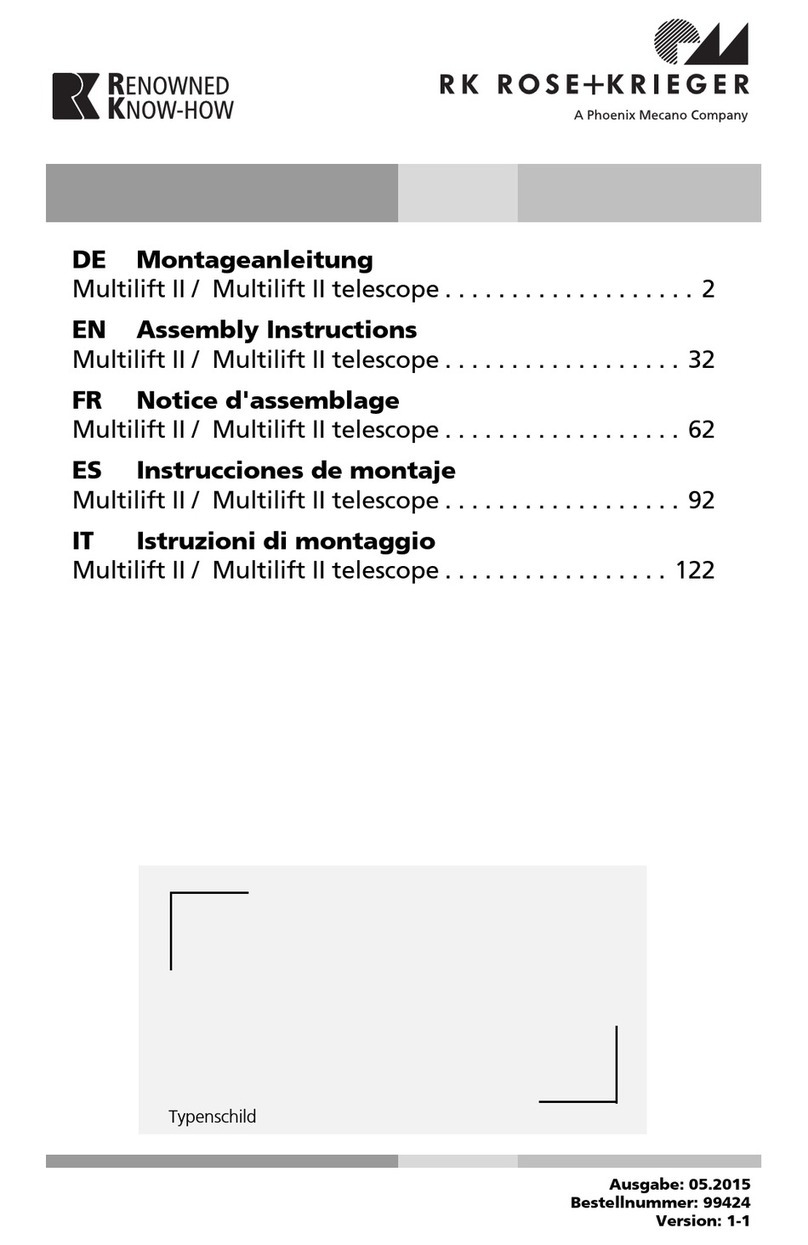
Phoenix Mecano
Phoenix Mecano RK Rose+Krieger Multilift II Assembly instructions
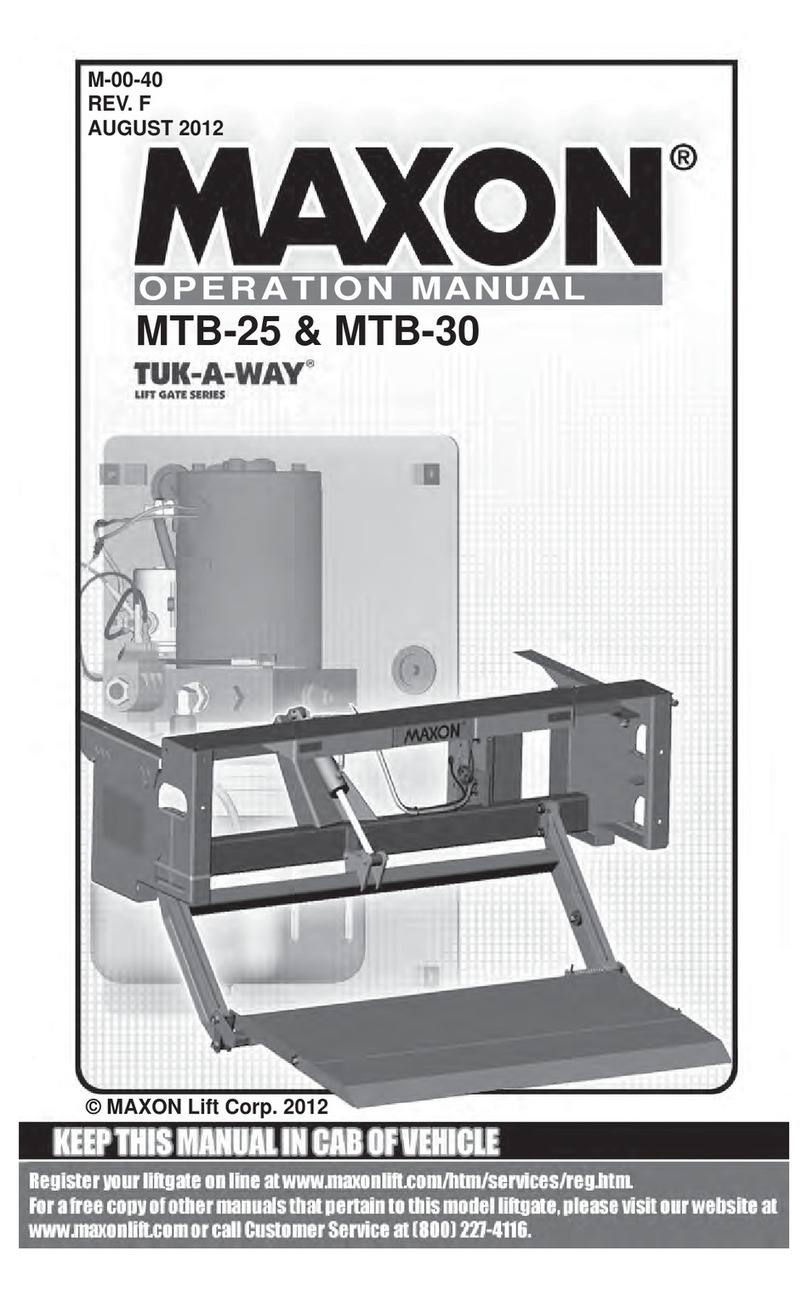
Maxon
Maxon TUK-A-WAY MTB-25 Operation manual

Bend-Pak
Bend-Pak HD-973P Service manual
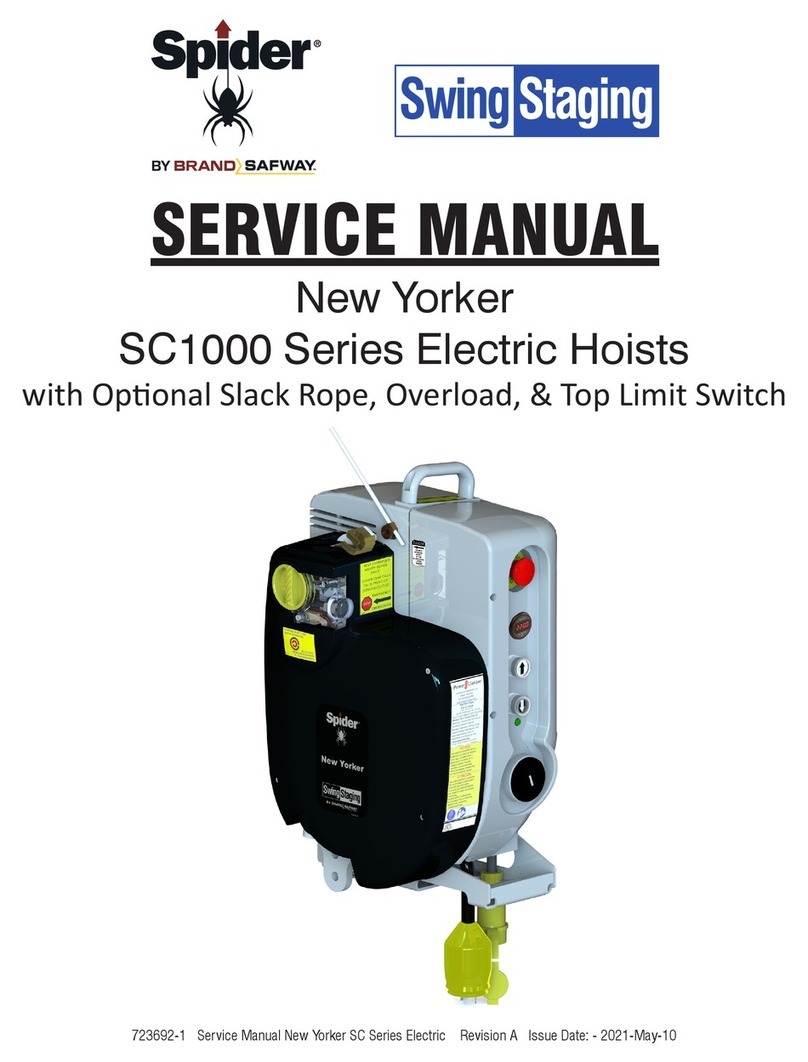
BrandSafway
BrandSafway Spider SC1000 Series Service manual
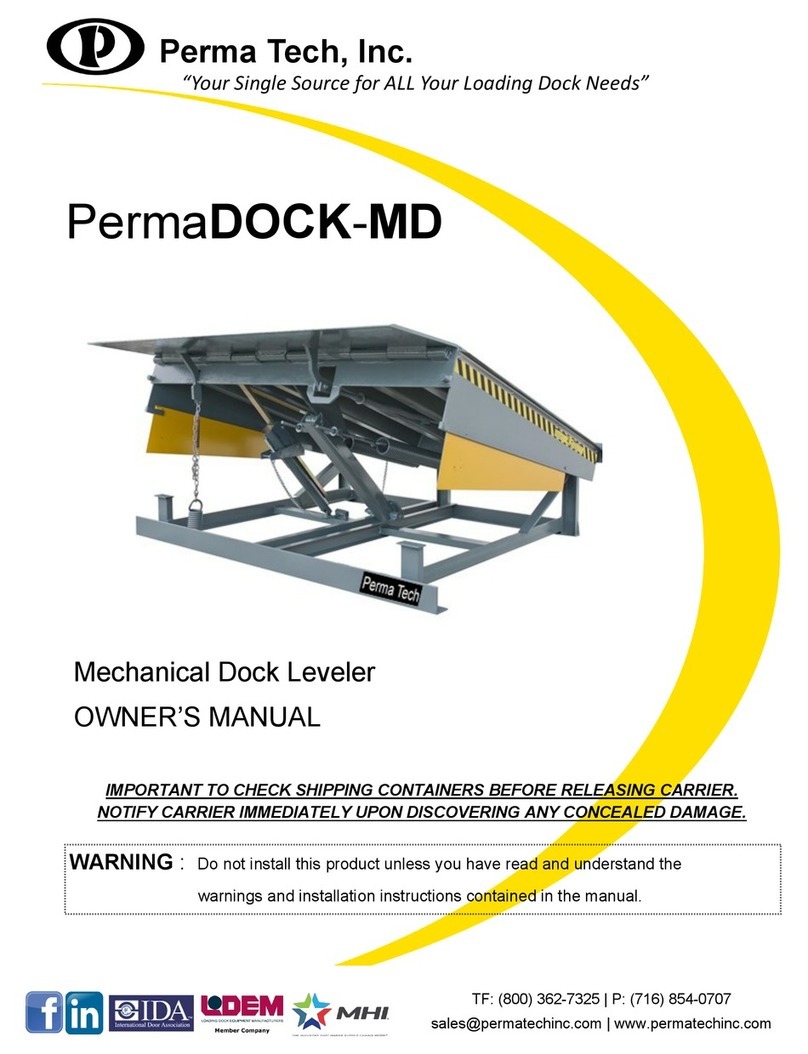
Perma Tech
Perma Tech PermaDOCK-MD owner's manual

PRO LIFTS
PRO LIFTS VMB TE-064 Operating instructions & user manual
